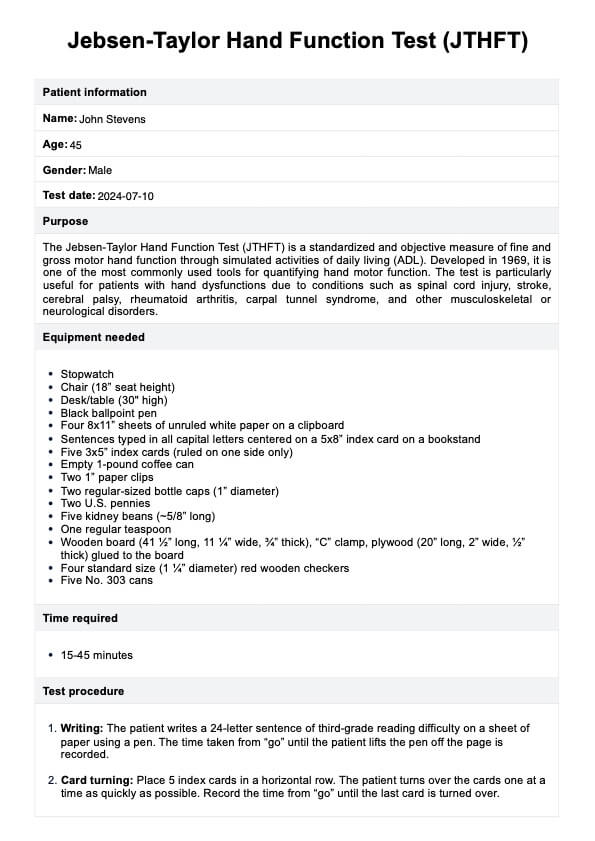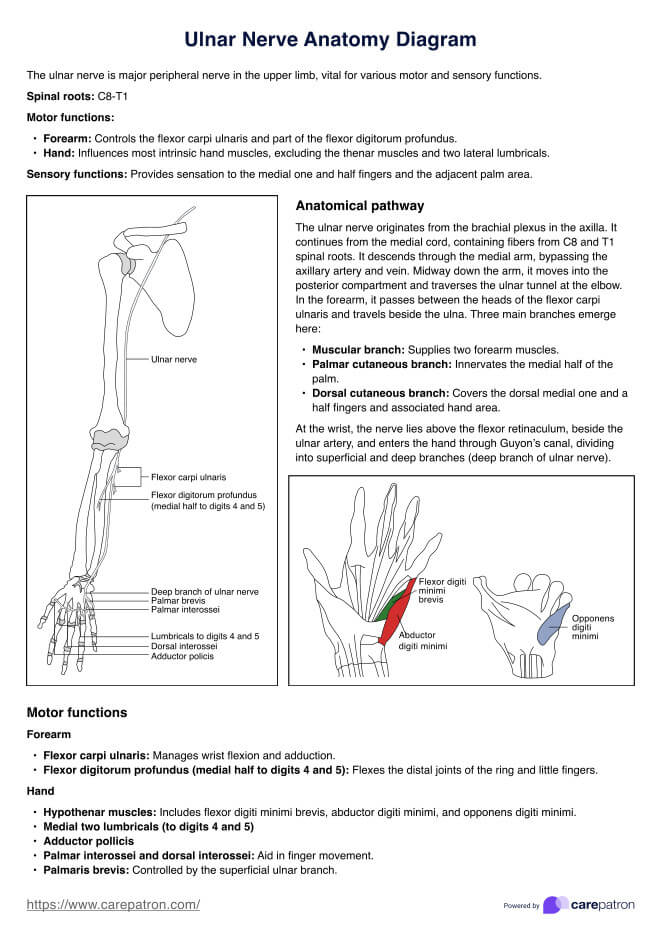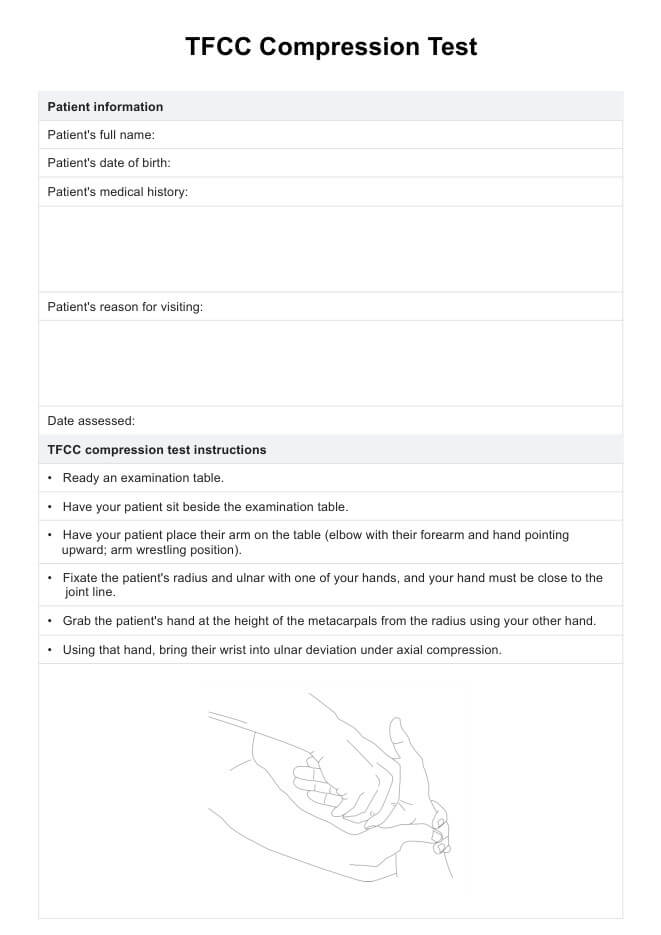Jebsen-Taylor Hand Function Test
Discover how our Jebsen-Taylor Hand Function Test template can streamline hand function assessments and improve patient care. Download now!


What is the Jebsen-Taylor Hand Function Test?
The Jebsen-Taylor Hand Function Test (JTHFT), also known as the Jebsen-Taylor Test, is a widely used assessment tool designed to evaluate hand function in individuals with various conditions affecting the upper extremities. Developed in 1969, the test provides an objective and standardized measure of fine and gross motor hand functions through activities that simulate daily living tasks. Studies have demonstrated its test-retest reliability and consistent results over time in various patient populations and conditions (Shirley Ryan Ability Lab, 2012).
The JTHFT is praised for its criterion validity and internal consistency in clinical and research settings. It offers healthcare professionals a comprehensive method for evaluating and tracking hand function and upper limb function over time. It is particularly beneficial for assessing patients with conditions such as spinal cord injury, stroke, cerebral palsy, rheumatoid arthritis, and carpal tunnel syndrome.
What is included in the Jebsen-Taylor Hand Function Test?
The Jebsen-Taylor Hand Function Test consists of seven subtests, each designed to assess different aspects of hand function through timed tasks. These subtests include:
- Writing a short sentence: Evaluates fine motor skills and dexterity required for writing.
- Turning over 3x5-inch cards: Simulates the action of turning pages or handling cards, assessing coordination and dexterity.
- Picking up small common objects: This involves picking up items like pennies, paper clips, and bottle caps and placing them in a container to test precision and grip.
- Simulated feeding: Uses a spoon to pick up beans and place them in a container, mimicking the action of eating.
- Stacking checkers: Tests hand-eye coordination by stacking checkers on each other.
- Moving large light objects: Involves transferring empty cans and assessing the ability to handle light but bulky objects.
- Moving large, heavy objects: Tests the ability to lift and move weighted cans, evaluating strength and control.
Each subtest is performed separately with the dominant and non-dominant hand, ensuring a comprehensive assessment of unilateral hand function and motor function.
Jebsen-Taylor Hand Function Test Template
Jebsen-Taylor Hand Function Test Example
How to use our Jebsen-Taylor Hand Function Test template
Our Jebsen-Taylor Hand Function Test template is an objective and standardized test designed to streamline the assessment process, providing a structured and easy-to-follow format. Follow these steps to use the template effectively:
Step 1: Download the template
Start by downloading our Jebsen-Taylor Hand Function Test template from our website. This template includes detailed instructions, a scoring grid, and space to record your observations and timings.
Step 2: Prepare the equipment
Gather all the equipment listed in the template, including a stopwatch, chair, desk, writing materials, and various test items such as cards, small objects, and cans.
Step 3: Familiarize yourself with the instructions
Review the instructions in the template to ensure you understand the procedure for each subtest. This will help you conduct the test efficiently and accurately.
Step 4: Conduct the test
Follow the step-by-step instructions in the template to administer each subtest. Record the time taken for each task using the stopwatch. Ensure you perform each subtest with both the non-dominant and dominant hands.
Step 5: Record and analyze the results
After completing the test, use the scoring grid in the template to sum up the times for each subtest. Compare the patient’s results with the normative data to evaluate their hand function.
Scoring and next steps of the Jebsen Test of hand function
The Jebsen-Taylor Hand Function Test (JTHFT) measures hand function by timing the completion of seven subtests, with the total score representing the sum of these times. Each subtest is designed to reflect everyday hand tasks, and shorter times indicate better performance. For an accurate assessment of upper extremity function, the test should be conducted with both non-dominant and dominant hands, and the results should be compared to established normative data (Park, Kim, & Kim, 2017). This comparison helps to determine the extent of hand dysfunction and monitor progress over time.
Once the scores are obtained, they should be analyzed against normative data to evaluate the patient’s hand function. A result greater than 2.0 standard deviations from the norm indicates significant hand dysfunction, suggesting further intervention. This analysis is crucial in developing targeted rehabilitation programs tailored to the patient’s specific needs, whether they have conditions such as stroke, cerebral palsy, or rheumatoid arthritis. The detailed breakdown of each subtest score provides insights into specific areas of difficulty, allowing for precise therapeutic interventions.
Following the assessment, clinicians can use the results of upper extremity function tests to guide treatment plans and set realistic goals for improvement. The JTHFT can be repeated regularly for patients with significant impairments to track progress and adjust interventions. By consistently monitoring and evaluating hand function, healthcare providers can ensure patients receive the most effective and individualized care, ultimately enhancing their quality of life.
Benefits of using our template
Our Jebsen-Taylor Hand Function Test template is designed to make the assessment process and physical medicine treatment plan straightforward and efficient. Here are three key benefits of using our template:
Streamlined process
Our template provides a clear and organized format for conducting the JTHFT, ensuring you have all the necessary instructions and recording sheets in one place. This helps streamline the testing process, saving time and reducing potential errors.
Accurate recording
With dedicated sections for each subtest and a built-in scoring grid, our template ensures accurate and consistent recording of test results. This precision is crucial for comparing patient performance to normative data and making informed clinical decisions.
Easy monitoring
The template allows for easy monitoring of patient progress over time. Using the same standardized format for each assessment, clinicians can track improvements or identify areas needing further intervention, leading to more effective patient management.
References
Shirley Ryan Ability Lab. (2012, October 26). Jebsen-Taylor Hand Function test | Rehabmeasures database. https://www.sralab.org/rehabilitation-measures/jebsen-taylor-hand-function-test
Park, B., Kim, S., & Kim, J. (2017). Neurorrhaphy of ulnar nerve with silicon wrapping in Guyon's canal to prevent neuropathy: A case report. Archives of Hand and Microsurgery, 22(4), 293–293. https://doi.org/10.12790/ahm.2017.22.4.293
Commonly asked questions
The Jebsen-Taylor Hand Function Test (JTHFT) is an assessment tool that evaluates hand function through a series of timed tasks that simulate everyday activities.
The test typically takes 15 to 45 minutes to complete, depending on the patient’s condition and the experience of the person administering it.
The test requires a stopwatch, writing materials, small everyday objects, checkers, empty and weighted cans, and a board for specific tasks.
Results are measured in seconds for each subtest, with lower times indicating better hand function. Scores are compared to normative data to evaluate the degree of hand dysfunction.
The JTHFT is a standardized test known for its reliability and validity in assessing hand function across various patient populations, including those with muscular dystrophies, cerebral palsy, stroke, and aging adults. It is often compared to the Box and Block Test, another standardized test that measures manual dexterity and hand function. Both tests are valuable for evaluating hand function but may be chosen based on specific patient needs and the aspects of hand function being assessed.







































































































